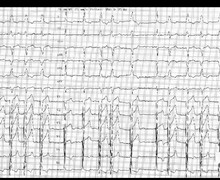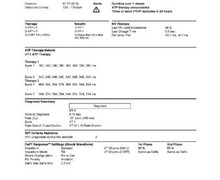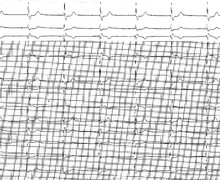Effective burst for VT
Tracing
Manufacturer Abbott
Device ICD
Field Therapy
N° 29
Patient
This 63-year-old woman suffering from advanced dilated cardiomyopathy received an Atlas dual chamber ICD for primary prevention, and was seen in routine consultation.
Main programmed parameters
- VF zone at 200 bpm and VT zone at 150 bpm
- 12 cycles in the VF or VT zones were needed for the diagnosis
- Sensitivity programmed at 0.3 mV
- VF zone: six 36-J (maximum strength) shocks; VT zone: 3 bursts followed by single 20-J shock, followed by shocks at maximum strength
- Discrimination in the VT zone
- DDD pacing at 60 bpm; DDI episode pacing mode; DDI post-shock pacing mode at 60 bpm

Graph and trace
Tracing
- Sinus rhythm (AS-VS);
- The initial cycles of the tachycardia are unclassified;
- DDI episode pacing mode after 4 cycles classified T;
- Episode of monomorphic VT with AV dissociation; after 12 T cycles, the device diagnoses VT with faster ventricular than atrial rate (VT >); in this V>A arm, no other discrimination criterion is implemented; the different morphology than the reference (x, 0) is noteworthy;
- 8 complexes of ATP at fixed rate = 85 % of the tachycardia, calculated as the average of the last 4 cycles, 7.5-V pulse amplitude and 1-ms pulse duration;
- 600-ms post-pacing blanking period;
- Effective burst of ATP and termination of the arrhythmia; restoration of sinus rhythm is diagnosed after 5 VS cycles without intervening F or T cycle; resumption of programmed DDD pacing mode.
Other articles that may be of interest to you







ATP is the therapy of first choice for VT at rate < 200 bpm because, compared with an electrical shock, it is painless and, by limiting the energy consumption, it lengthens the life of the battery. In the <200 bpm VT zone, ATP may be programmed in the majority of patients who are in heart failure and have undergone ICD implants for secondary prevention indications. It may also be programmed in primary prevention indications, unless it has been found ineffective or arrhythmogenic. In this range of heart rate, ATP successfully terminates 90% of VT, at the cost of an incidence of VT acceleration or evolution toward VF that is not ≤1%.